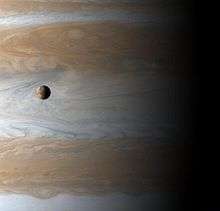Cassini–Huygens retirement

The planned end of mission for Cassini is disposal by a controlled fall into Saturn's atmosphere on September 15, 2017.[1][2] This method was chosen because it is imperative to ensure protection and prevent biological contamination to any of the moons of Saturn now thought to offer potentially habitable environments.[3]
However, this plan was chosen prior to future planetary flagship missions being put on hold indefinitely in 2013.[4] Factors that can affect the mission end method are the amount of rocket fuel it has left, the health of the spacecraft, and funding for operations on Earth.[5]
Some possibilities for Cassini's later stages were aerobraking into orbit around Titan,[5] leaving the Saturn system,[5] or making close approaches and/or changing its orbit.[5] For example, it could collect solar wind data in a heliocentric orbit.[1]
End of mission planning
| Color | Meaning[1] |
|---|---|
| Red | Poor |
| Yellow | Fair |
| Light Green | Good |
| Green | Excellent |
During planning for its extended missions, various future plans for Cassini were evaluated on the basis of science return, cost, and time.[1][6] Some of the options examined include collision with Saturn atmosphere, an icy satellite, or rings; another was departure from Saturn orbit to Jupiter, Uranus, Neptune, or a centaur.[1] Other options included leaving it in certain stable orbits around Saturn, or departure to a heliocentric orbit.[1] Each plan requires certain amounts of time and changes in velocity.[1] Another possibility was aerobraking into orbit around Titan.[5]
This table is based on page 19 of Cassini Extended Missions (NASA), from 2008.[1]
| Option | Set-up requirements | Execution time | Operability +
assurance of EOL |
Velocity change (delta-v)
required |
Science evaluation circa 2008 |
|---|---|---|---|---|---|
| Saturn impact – short-period orbits | High inclination achievable via any XXM design | 2–10 months total | Short time between last encounter and impact | 5–30 m/s | D-ring option satisfies unachieved AO goals; cheap and easily achievable |
| Saturn impact – long-period orbits | Specific orientation and inclination required | 4–22 months to set up long period orbit + 3 years for final orbit | 3 years between last encounter and impact | 5–35 m/s | Operations costs required for 3 years with no science could be applied elsewhere |
| Impact icy satellite | Can be implemented from any geometry | 0.5–3 months total | Short time between last encounter and impact | 5–15 m/s | Cheap and achievable anywhere/time |
| Impact main rings | Can be implemented from any geometry | 0.5–3 months total | Short time between last encounter and impact but difficult to prove spacecraft destruction | 5–15 m/s | Cheap and achievable anywhere/time; close-in science before impact |
| Escape to giant planet | Specific orbit period, orientation and inclination required + specific departure dates | 1.4–2.4 years to escape + long transfer time (Jupiter 12 years, Uranus 20 years, Neptune 40 years) | Planetary impact can only be guaranteed shortly after escape for Jupiter | 5–35 m/s | Giant-planet science unlikely |
| Escape to heliocentric orbit | Can be implemented from any geometry | 9–18 months to escape, open-ended Solar orbit | Last encounter goes to escape | 5–30 m/s | Solar wind data only |
| Escape to Centaur | Large target set offers wide range of departures | 1–2 years to escape + 3+ year transfer | Last encounter goes to escape; must maintain teams for 3+ years for centaur science | 5–30 m/s | Multi-year lifetime and funding seems better spent in target-rich Saturnian environment |
| Stable orbit outside Titan | Specific orientation and orbit period required | 13–24 months + open-ended time in stable orbit | 200 days between last encounter and final orbit | 50 m/s | Limited Saturn / magnetospheric science, but for long period of time |
| Stable orbit outside Phoebe | Specific orientation and orbit period required | 8+ years + open-ended time in stable orbit | Many months between last encounter and final orbit | 120 m/s | Solar wind data; very rare passages through magnetotail |
On July 4, 2014, the Cassini science team announced that the proximal orbits of the probe would be named the "Cassini Grand Finale". This would be immediately preceded by a gradual shift in inclination to better view Saturn's polar hexagon, and a very close flyby of Enceladus to closer study its cryovolcanism.[7]
See also
References
- 1 2 3 4 5 6 7 8 9 10 Spilker, Linda (April 1, 2008). "Cassini Extended Missions" (PDF). Lunar and Planetary Institute. Archived (PDF) from the original on April 23, 2008.
- ↑ Mason, Betsy (February 3, 2010). "Cassini Gets Life Extension to Explore Saturn Until 2017". Wired. Archived from the original on February 9, 2010.
- ↑ Blabber, Phillipa; Verrecchia, Angélique (April 3, 2014). "Cassini-Huygens: Preventing Biological Contamination". Space Safety Magazine. Retrieved 2015-08-01.
- ↑ Whittington, Mark (February 15, 2012). "NASA Flagship Planetary Missions on Hold Indefinitely". Yahoo. Archived from the original on September 2, 2013.
- 1 2 3 4 5 Bailey, Frederick; Rabstejnek, Paul. "Cassini Mission and Results". Oglethorpe University. Archived from the original on February 19, 2008.
- ↑ Pappalardo, Bob; Spiker, Linda (March 15, 2009). "Cassini Proposed Extended-Extended Mission (XXM)" (PDF). Lunar and Planetary Institute. Archived (PDF) from the original on July 18, 2012.
- ↑ "Cassini Names Final Mission Phase Its 'Grand Finale'". Astrobiology Magazine. July 4, 2014. Retrieved 2015-08-01.